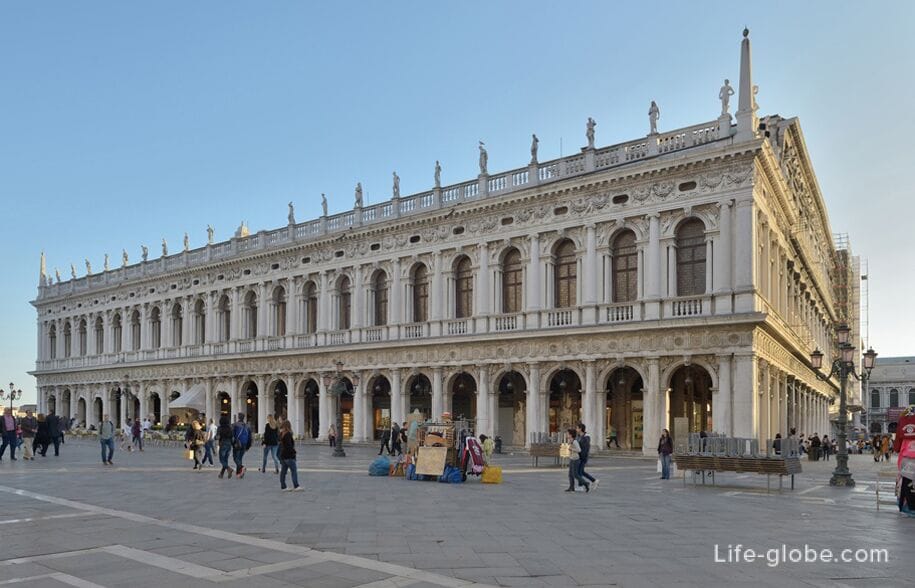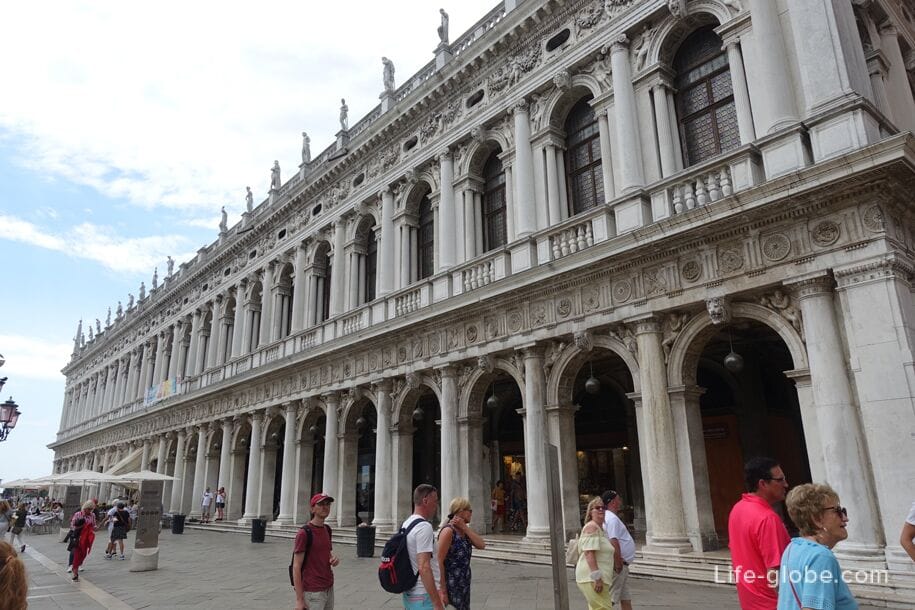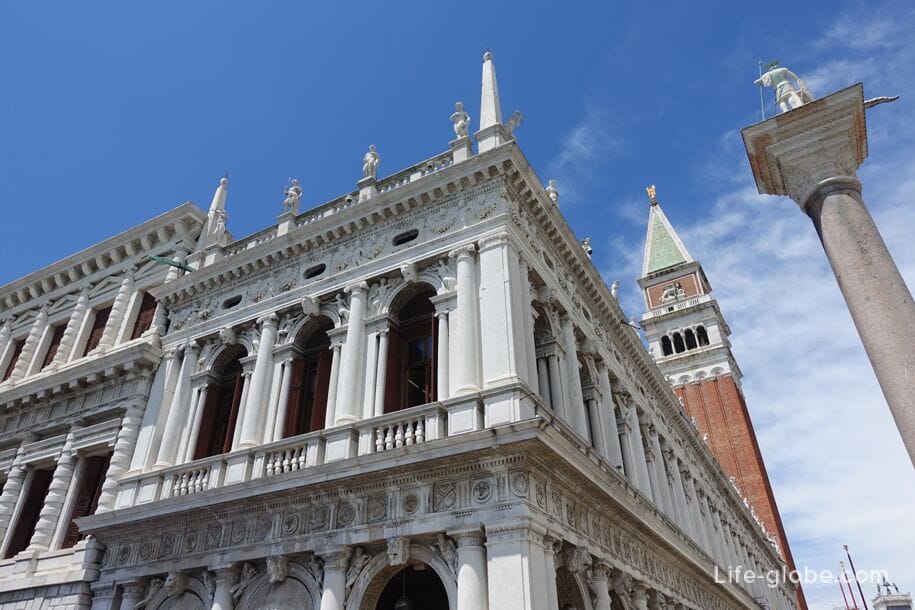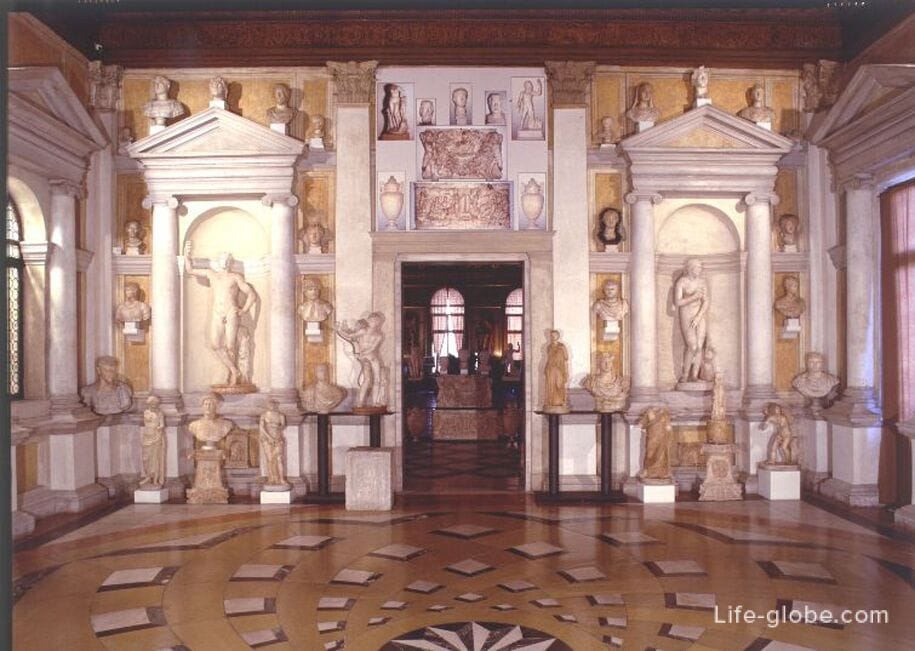
The Marciana Library or San Marco Library, also known as the Sansovino Library (Biblioteca Nazionale Marciana, Libreria pubblica di san Marco, Libreria sansoviniana) is the national public and most important library of Venice, which is one of the largest Italian libraries.
The name of the library "San Marco" was given in honor of St. Mark the Evangelist, the patron saint of Venice, and "Sansovinskaya" - in honor of its architect, Jacopo Sansovino.
There are reading rooms in the library, and for tourist purposes it is proposed to visit the historical monumental halls of the library (the historical part of the library).
The Marciana Library is located in the main square of Venice - Piazza San Marco (Piazza San Marco), the former political and religious center of the Republic of Venice, next to the famous Doge's Palace (Palazzo Ducale), which is now a museum.

The construction of the library building was started by the Italian architect and sculptor Jacopo Sansovino in 1537 during the program to raise the prestige of Venice, begun under Doge Andrea Gritti. After Sansovino's death, Vincenzo Scamozzi completed the work in 1570.
The library was built to store valuable books and manuscripts, including books donated in 1362 by Francesco Petrarch of the Republic, as well as the book collection of the Greek Cardinal Bessarion, which arrived in Venice in 1469 and was located in the nearby Doge's Palace. The building also housed the offices of the San Marco Prosecutor's Office.
Over time, the library's collections grew, and it occupied neighboring buildings, including the nearby Mint of the Republic of Venice (Zecca di Venezia), designed by Jacopo Sansovino in 1537-1547.
In 1596, a Public Sculpture of the Republic was opened in the adapted lobby of the library to accommodate Greek and Roman statues donated by Cardinal Giovanni Grimani, combined with other works by Federico Contarini.
In recent times, the historical building has been called the "Sansovino Library" and it has largely become a museum, where the lobby and hall are mainly intended for exhibitions and events. Also, the ground floor was converted into shops and cafes.
Today, the Marciana Library stores, in addition to valuable books and manuscripts, many works by outstanding artists of Venice of the sixteenth century, which makes it a unique monument of the art of Venice: architecture, sculpture and painting.

The architecture of the historical library building has stylistic features referring to Roman models. Thus, the library has the appearance of a solid loggia on a small portico, which is characterized by Doric arcades decorated with a Doric entablature, alternating triglyphs and metopes; also, the Ionic order of the upper loggia shows a rich frieze depicting cherubs and festoons of flowers and fruits.
The upper part of the building is completed by a balustrade with three angular obelisks and a series of statues of classical deities by Alessandro Vittoria and other famous artists.
Initially, Sansovino designed the vaulted roof of the library, but it collapsed in December 1545 and was later replaced by a large terrace.
Sansovino built the first sixteen arches of the library from 1537 to 1553, and Vincenzo Scamozzi continued the work in 1588 and built the last five arches to the pier.



Anyone can visit the monumental halls of the Marcian Library today, they are a museum area where temporary exhibitions and events take place.
The monumental halls of the library are the ancient library of San Marco, which includes an honorary staircase, a vestibule, later converted into a sculptural part, and a hall. This historical and artistic part is of considerable value, mainly illustrating the iconographic path with rich pictorial decoration present in the rooms, as well as works by famous artists such as Titian Vecellio, Paolo Veronese and Tintoretto.
The staircase with two flights with a vaulted ceiling is decorated with stucco work by Vittoria and paintings by Battista Franco. Iconography hints at the process of ascension of the spirit in a Neoplatonic perspective: a person conditioned by planets and elements (the first stage) comes through the exercise of virtue (the second stage) to wisdom, which finds its most accurate reflection in the stucco of Vittoria, which closes the cycle at the top and depicts a woman holding a book and a circle, a symbol of eternity.
Along the staircase are six Roman columns of rare marble, coming from the Basilica of Santa Maria in Cannedolo in Pola.
In the dome of the ceiling, you can admire the stucco and panels depicting music hinting at cosmic harmony.

The staircase leads to the Vestibule or Antisale where there is a painting by Titian called "Sapienza" (Wisdom) from 1560.
Between 1591 and 1595, the vestibule, designed by Patriarch Grimani and Vincenzo Scamozzi, was transformed into a Sculpture Museum of the Republic, after the donation of a collection of antiquities by the Patriarch of Aquileia Giovanni Grimani himself. It was one of the most important collections in Europe, especially interesting because the patriarch preferred Greek originals to Hellenistic copies.
The walls of the lobby have niches, pilasters, pediments and cornices, which gives the room an antique style; there is also a collection of Greek and Roman statues.

From the lobby through the portal you can go to the library room, built specifically for the storage of Cardinal Bessarione's book collection.
Between 1562 and 1572, numerous portraits of ancient philosophers were placed on the walls of the hall to recreate an environment similar to that in ancient libraries.
The ceiling is painted on the theme of nature, gods and sciences.
In the center of the Sansovino Hall there are now two globes by Vincenzo Coronelli: the terrestrial globe (Venice 1688, diameter 108 centimeters) and the celestial globe (Venice-Paris 1688-89, diameter 108 centimeters).

Entrance to the museum part of the Marcian Library is paid. There are discounted tickets. Children under 6 years old - free of charge.
Every second Sunday of the month, the library offers a free tour of the halls in Italian.
A ticket to visit the library is included in a comprehensive ticket to visit other museums on St. Mark's Square: the Doge's Palace (Palazzo Ducale), the Correr Museum (Museo Correr) and the National Archaeological Museum (Museo Archeologico Nazionale). The ticket is valid for 3 months and allows one entrance to the Doge's Palace and one entrance to the integrated route of the other three objects (the library, the Correr Museum and the Archaeological Museum).
There are complex tickets for 6 months, with visits to the Monumental Halls of the Marciana Library of the Doge's Palace and other public museums of Venice.
Tickets can be purchased at the box office or online in advance on the website.
Up-to-date information about visiting the library, including possible premises and exhibitions, free excursions; cost, validity period and places of purchase of tickets; conditions of visits, opening hours of the library, etc., we recommend checking on the official website of the Marcian Library: bibliotecanazionalemarciana.cultura.gov.it.
The address of the Marcian Library is Piazzetta San Marco 7, 30124 Venezia VE, Italy.
Coordinates of the Marcian Library: 45°26'00.0"N 12°20'21.0"E (45.433333, 12.339167).
All accommodation facilities in Venice, including in the historic city center and near St. Mark's Square, can be viewed and booked here